Marie Joséphine of Savoy
| Marie Joséphine of Savoy | |||||
|---|---|---|---|---|---|
| Countess of Provence | |||||
 Portrait by Jean-Martial Frédou | |||||
| Born |
2 September 1753 Royal Palace of Turin, Turin | ||||
| Died |
13 November 1810 (aged 57) Hartwell House, Buckinghamshire, England | ||||
| Burial | Cagliari Cathedral, Cagliari | ||||
| Spouse | |||||
| |||||
| House | Savoy | ||||
| Father | Victor Amadeus III of Sardinia | ||||
| Mother | Maria Antonia Ferdinanda of Spain | ||||
| Religion | Roman Catholicism | ||||
| Signature |
| ||||
Marie Joséphine Louise of Savoy (Italian: Maria Giuseppina Luigia; 2 September 1753 – 13 November 1810) was a Princess of France and Countess of Provence by marriage to the future King Louis XVIII of France. She was by Bourbon Royalists regarded as titular Queen of France when her husband assumed the title of King in 1795 upon the death of his nephew, the titular King Louis XVII of France, until her death. In reality she never had this title, dying before he truly became King in 1814.
Life
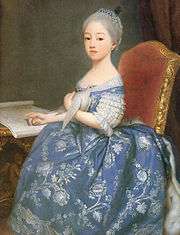
Marie Joséphine was born at the Royal Palace of Turin on 2 September 1753 as the third child and second daughter of Prince Victor Amadeus of Savoy and Infanta Maria Antonia Ferdinanda of Spain. At the time of her birth, her paternal grandfather Charles Emmanuel III was the King of Sardinia, thus her parents were styled Duke and Duchess of Savoy.[1]:39 Her brothers included the last three kings of Sardinia from the senior line of the House of Savoy: the future Charles Emmanuel IV, Victor Emmanuel I, and Charles Felix.
Marriage
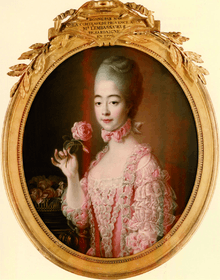
Marie Joséphine was engaged to the French prince Louis Stanislas, Count of Provence. Her aunts, Maria Luisa of Savoy and Eleonora of Savoy, were once proposed as brides for Louis Stanislas's father Louis.
The marriage was arranged as a part of a series of Franco-Savoyard dynastic marriages taking place in a time span of eight years: after the wedding between her cousin Princess Marie Louise of Savoy and Louis Alexandre, Prince of Lamballe,[2]:7 and the wedding between Marie Joséphine and Louis Stanislas, her younger sister Maria Theresa was married to her younger brother-in-law, the Count of Artois (future King Charles X of France) in 1773, and her eldest brother Prince Charles Emmanuel of Savoy (the future king of Sardinia) was married to her sister-in-law Princess Clotilde of France in 1775. Her eldest brother-in-law, Dauphin Louis Auguste (the future Louis XVI of France), had married Marie Antoinette one year earlier.[3]
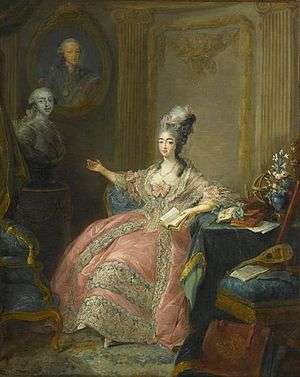
Marie Joséphine was married on 16 April 1771 by proxy in the Kingdom of Sardinia,[1]:7 then again in person on 14 May 1771 at the Palace of Versailles. The wedding ceremony by proxy, followed by a bedding ceremony and a banquet, was held at the Savoyard royal court in Turin, after which the bride crossed bridge of Beauvoisin between Savoy and France, where she left her Italian entourage and was welcomed by her new French retinue. She was introduced to the French royal family and court at the Palace of Fontainebleau, where she was met by her cousin the princesse de Lamballe.[2]:53 A ball followed the wedding on 20 May.[4]
Her marriage to a Petit-fils de France (Grandson of France) allowed her to assume the rank of petite-fille de France (Granddaughter of France). At the death of her husband’s grandfather Louis XV in 1774, her brother-in-law succeeded as Louis XVI; as the eldest brother of the king, her spouse took on the style Monsieur, and Marie Joséphine was thus under the reign of her brother-in-law known under the style of Madame.
Countess of Provence
The marriage of Marie Joséphine had been deemed necessary by Louis XV because the dauphin had not consummated his marriage, and there may thus prove to be necessary to leave the task to provide the next heir to the throne to the count of Provence, who was second in line in succession after his brother.[2]:53 The Franco-Savoyard marriage alliance was greatly disliked by Austria and Empress Maria Theresa, who feared that Marie Joséphine might gain influence upon Louis XV in France in favor of Savoy, which was the rival of Austria in Northern Italy, and that she would undermine the position of the childless Marie Antoinette if she gave birth to an heir to the French throne while the marriage of the Dauphin was still unconsummated.[5]
Marie Joséphine received 300,000 livres' worth of jewels from Louis XV, three-quarters of the Dauphine’s casket, and from Provence his portrait as "a pledge of the sentiments that are engraved in my heart for you."[5]
She did not make a good impression upon her arrival in France, and was described as small, plain, with a sallow skin and what Louis XV called “a villainous nose”, and as a person as timid, gauche and "ill educated in all those graces considered so important at Versailles", coming from the more strict Savoyard court, where rouge was found repugnant.[5] It was alleged that she never brushed her teeth, plucked her eyebrows, or used any perfumes.[6] Her private quarters and bathroom were not ready at the time of her arrival, making it difficult for her to wash herself after spending days in a carriage riding from Turin to Versailles, and she was also not able to do so in the days following her arrival.[7] In order to rectify the bad impression of her appearance, the ambassador to France from Savoy was required to ask her father to tell her about the necessity for a careful toilette, in particular with regard to her teeth and hair: “It is embarrassing for me to discuss such things, but these mere details to us are vital matters in this country”,[5] and her chief lady-in-waiting, the Duchess de Valentinois, informed her that she must use rouge in order to please her spouse, upon which she agreed to adjust herself to the customs in France.[5]
Her spouse Louis Stanislas, aware of the gossip surrounding the unconsummated marriage of his elder brother the Dauphin, did not follow his elder brother's example of silence in regard to his own consummation but in contrast made a point of boasting of vigorous conjugal relations between him and his spouse.[5] It was however widely doubted that the marriage was consummated. Louis Stanislas suffered from great overweight and difficulty of movement, and Marie Antoinette dismissed the boasting and assured her mother that a consummation of his marriage “would need a miracle”;[5] years later the Savoyard ambassador to France reported that there was never a question of a physical union between them, while Marie Joséphine herself reported in February 1772 that she was quite sure she was not pregnant “and it’s not my fault.”[5] Louis Stanislas reportedly proclaimed his wife to be pregnant merely to spite Louis Auguste and Marie Antoinette, who had not yet consummated their marriage.[8] Marie Joséphine reportedly suffered a miscarriage in 1774.[9] A second pregnancy in 1781 also miscarried, and the marriage remained childless.[10][11]
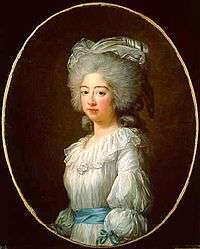
During her first years in France, the three royal couples; the count and countess of Provence, the count and countess of Artois, the Dauphin and Dauphine, as well as the princesse de Lamballe, who was the favorite of Marie Antoinette, formed a circle of friends and acted in amateur theater plays together, before an audience only consisting of the dauphin.[2]:56–57 During these years, the count and countess of Provence is frequently mentioned as accompanying the crown prince couple on sleigh rides, masquerades, opera performances and other entertainments.[12] As the second lady of the French court after the queen, she alternated with the Mesdames de France in accompanying Marie Antoinette on official representational assignments.[13]
The seemingly good relationship between the four couples somewhat deteriorated, however, after the succession of Louis XVI to the throne in 1774. Louis XVI and Louis Stanislas did not enjoy a harmonious relationship. They often quarreled,[14] as did their wives.[15] The Count of Provence actually challenged the legitimacy of Marie Antoinette's first child, and until the birth of a male heir by Marie Antoinette, he did everything in his power to promote himself and his wife as better fitted to be next-in-line for the throne. Without children or political influence, Marie Joséphine intrigued against the queen, but without much success, while her spouse orchestrated a true country-wide opposition against her. She was quite well educated in literature - she had her own library installed in her apartments - and was estimated to have been of no small intelligence and with a good ability to accustom to court intrigues.[13] The brother of Marie Antoinette, Emperor Joseph II, said of her during his visit to France in 1777 that she was "ugly and vulgar, not a Piedmontese for nothing, a mess of intrigues."[13]
Marie Joséphine and her spouse lived largely separate lives, and while Louis Stanislaus was reputed to have a romantic relationship with his favorite courtier, the Duke d'Avaray, Marie Joséphine was reputed to have a romantic relationship with her favorite lady-in-waiting Marguerite de Gourbillon.[16] She preferred to reside in her private retreat villa, the Pavillon Madame in Montreuil, on which she spent lavishly and constructed a fashionable model village with a pavilion of music, and a model village with twelve houses, dovecotes and windmills, a dairy made of marble with silver vessels, as well as allegorical temples consecrated to love and friendship, a hermitage and a belvedere.[5]
Prior to the meeting of the Estates General, every member of the royal family was publicly mocked by libelous verses, in which Marie Joséphine was satirized for her alleged alcoholism.[5]
Revolution
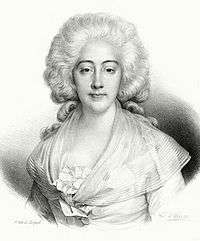
In contrast to her sister and brother-in-law the count and countess of Artois, who left France soon after the Storming of the Bastille in July 1789, the count and countess of Provence remained in France after the outbreak of the revolution. They were present at the Palace of Versailles during The Women's March on Versailles, which took place on 5 October 1789.
After the Women's March, they were forced to move to Paris along with Louis XVI and Marie Antoinette. However, while the rest of the royal family stayed in the Tuileries Palace, Marie Joséphine and her spouse lodged in the Luxembourg Palace, which was their normal city residence in Paris.[17] They regularly attended court in the Tuileries and were also present at the evening family suppers, were Marie Joséphine were described as humorous and entertained with character reading of people's faces.[5] Their presence was welcomed by the queen at this point, as Marie Antoinette came to distrust strangers for political reasons and turned to her family for company.[2]
In June 1791, the Provence couple successfully escaped to the Austrian Netherlands in the same operation that led to the royal family’s failed Flight to Varennes.[18] The Provence couple was more successful as they left separately and more discreetly: Louis Stanislaus left dressed as English merchant only accompanied by one courtier, his favorite d'Avraye, and Marie Joséphine left only in the company of one lady-in-waiting, her favorite Gourbillon. They each passed the border with no difficulty whatsoever, and reunited in Namur.[5]
Exile
After having reunited with Louis Stanislaus in Brussels in the Austrian Netherlands, Marie Joséphine accompanied him to Germany, where he created a royal émigré court in exile in Koblenz and Trier. Marie Joséphine however did not wish to stay with her husband for long. Already in the 25th of July the Duke of Genevois wrote in his journal that she was coming home to the court of her father in Turin: "Piedmont has told me, that Madame is coming here, but that the King insists on her coming alone. . . . Anyhow, one thing is certain — where she is at present, she is starving and without a penny."[19] She was asked to come without her spouse, as her father was already in a difficult diplomatic situation with the French government due to the great number of aristocratic refugees in Savoy. She was duly welcomed in her former home country in early 1792.[19]
In the end of 1794, the Provence couple moved from Turin to Verona. On 8 June 1795, Louis XVII of France, the only surviving son of Louis XVI and Marie Antoinette, died while imprisoned in the Temple, and on 16 June, the exiled French court proclaimed the Count of Provence King of France as Louis XVIII. Thus, Marie Joséphine became regarded as titular Queen consort of France by the royalists. During this period of exile, the Count and Countess fought constantly. Some historians have suggested Marie Joséphine's possible relationship with Marguerite de Gourbillon was the primary cause.[16]
In 1796, Marie Joséphine and Louis Stanislaus left Verona due to the French invasion of Northern Italy by Napoleon Bonaparte and fled to Germany, where they separated - Louis Stanislaus moving to Blankenburg, while Marie Joséphine settled in Schleswig-Holstein with Marguerite de Gourbillon.[16] In 1799, she was asked by Louis to join him in Jelgava in Russian Courland to attend the wedding between her husband's niece Marie Thérèse, the only remaining child of Louis XVI and Marie Antoinette, to her nephew Louis-Antoine, Duke of Angoulême, at the French court-in-exile, which operated under the protection of the Russian Tsar Paul I. Louis demanded that she leave Gourbillon behind. After having written to the Tsar to ask him to intervene on Gourbillon's behalf, and having received no reply, they travelled there together. When Marie Joséphine arrived with Gourbillon, their carriage was stopped before they reached the palace in Jelgava, and Gourbillon was forcibly separated from Marie Joséphine, who reacted with a public protest in front of the whole court upon her arrival. She openly declared that she would refuse to change out of her clothes or install herself in her quarters before Gourbillon was given permission to join her.[16] This tactic was unsuccessful, and instead she thereafter refused to leave her rooms, where she isolated herself with a bottle of liquor.[16] This scene caused a public scandal. Gourbillon later managed to have her revenge by convincing the tsar to expel Louis from Russia early in 1801.[16] Marie Joséphine left Louis and Mitau again not long after the wedding.

In 1804, however, she was forced to return to Louis in Mitau against her will, since his deteriorating finances could no longer afford two separate households.[16] In 1808, Marie Joséphine left Mitau in the company of Marie Thérèse to join her spouse in England, where they were allowed to set up a French exile court in Hartwell House, the English residence of the exiled French royal family. She was ill with edema upon her arrival in England and lived very discreetly until her death two years later.
Death
Marie Joséphine died on 13 November 1810 of that edema.[20] Surrounded in her final days by most of the French court, she begged for forgiveness for any wrongs she might have done them, especially Louis; she assured him that she harboured no ill will toward him. Her funeral was a magnificent occasion attended by all the members of the court-in-exile, whose names were recorded by police spies and reported back to Napoleon.[16] The funeral cortege was followed by the carriage of the British royal family, and Marie Joséphine was laid to rest in the Lady Chapel of Westminster Abbey.[21]
Her body was removed a year later on Louis's orders and buried in the Kingdom of Sardinia; today it lies in Cagliari Cathedral. There, her brother King Charles Felix of Sardinia had an imposing monument erected over her grave, whereon she is described personally as "sapiens, prudens, pientissima" ("wise, prudent, kindest") and as "Galliarum Regina", literally "Queen of the Gauls", i.e. of France.[5]
Ancestry
In fiction and film
The Countess of Provence was played by French actress Clémentine Poidatz in the 2006 motion picture Marie Antoinette directed by Sofia Coppola.[23] The film portrays her as the mother of the Duke of Angoulême (Louis XIX), who was really the son of her sister Princess Maria Theresa of Savoy.[24]
References
| Wikimedia Commons has media related to Princess Marie Josephine Louise of Savoy. |
- 1 2 Reiset, Tony Henri Auguste de (1913). Joséphine de Savoie, comtesse de Provence, 1753-1810 (in French). Émile-Paul frères. Retrieved 1 September 2018.
- 1 2 3 4 5 Hardy, Blanche Christabel (1908). The Princesse de Lamballe; a biography. London: A. Constable.
- ↑ Almanach royal: 1785 [Royal Almanac: 1785] (in French). Laurent D'Houry. 1785. p. 33.
- ↑ Mansel, Philip (2005). Louis XVIII. John Murray. p. 3. ISBN 0-7195-6709-2.
- 1 2 3 4 5 6 7 8 9 10 11 12 13 Fraser, Antonia,Marie Antoinette: The Journey ORION, London 2002, ISBN 978-0-7538-1305-8
- ↑ Mansel, 13–14
- ↑ Versailia 2007
- ↑ Fraser, 115
- ↑ Mansel, 14–15
- ↑ Mansel, 10
- ↑ Mansel, 13–14
- ↑ Bertin, Georges: Madame de Lamballe, New York : G. A. S. Wieners, 1901
- 1 2 3 Joan Haslip (1991). Marie Antoinette. Stockholm: Norstedts Förlag AB. ISBN 91-1-893802-7
- ↑ Fraser, 120
- ↑ Mansel, 111
- 1 2 3 4 5 6 7 8 Nagel, Susan. Marie-Therese, Child of Terror: The Fate of Marie Antoinette's Daughter, 2008
- ↑ Fraser, 361–362
- ↑ Fraser, 412
- 1 2 Artemont, Louis Leopold d' (1911). A sister of Louis XVI, Marie-Clotilde de france, queen of Sardinia (1759-1802). London: J. Murray. pp. 55–56.
- ↑ Nettement, Alfred François (1859). Vie de Marie-Thérèse de France fille de Louis XVI. Jacques Lecoffre et Cie. pp. 295–296. Retrieved 1 September 2018.
- ↑ Cf. "The Countess de Lisle", The Times (16 November 1810): 3; "The Queen of France's Funeral", The Times (28 November 1810): 3.
- ↑ Genealogie ascendante jusqu'au quatrieme degre inclusivement de tous les Rois et Princes de maisons souveraines de l'Europe actuellement vivans [Genealogy up to the fourth degree inclusive of all the Kings and Princes of sovereign houses of Europe currently living] (in French). Bourdeaux: Frederic Guillaume Birnstiel. 1768. p. 26.
- ↑ Marie Antoinette at AllMovie
- ↑ Guichen, Eugène (1909). Le Duc d'Angoulême (1775-1844) (in French) (2nd ed.). E. Paul. p. 1.
Marie Joséphine of Savoy Born: 2 September 1753 Died: 13 November 1810 | ||
| Titles in pretence | ||
|---|---|---|
| Preceded by Marie Antoinette of Austria |
— TITULAR — Queen consort of France and of Navarre 8 June 1795 – 13 November 1810 Reason for succession failure: French Revolution (1789–1799) |
Vacant Title next held by Marie Thérèse of France |
